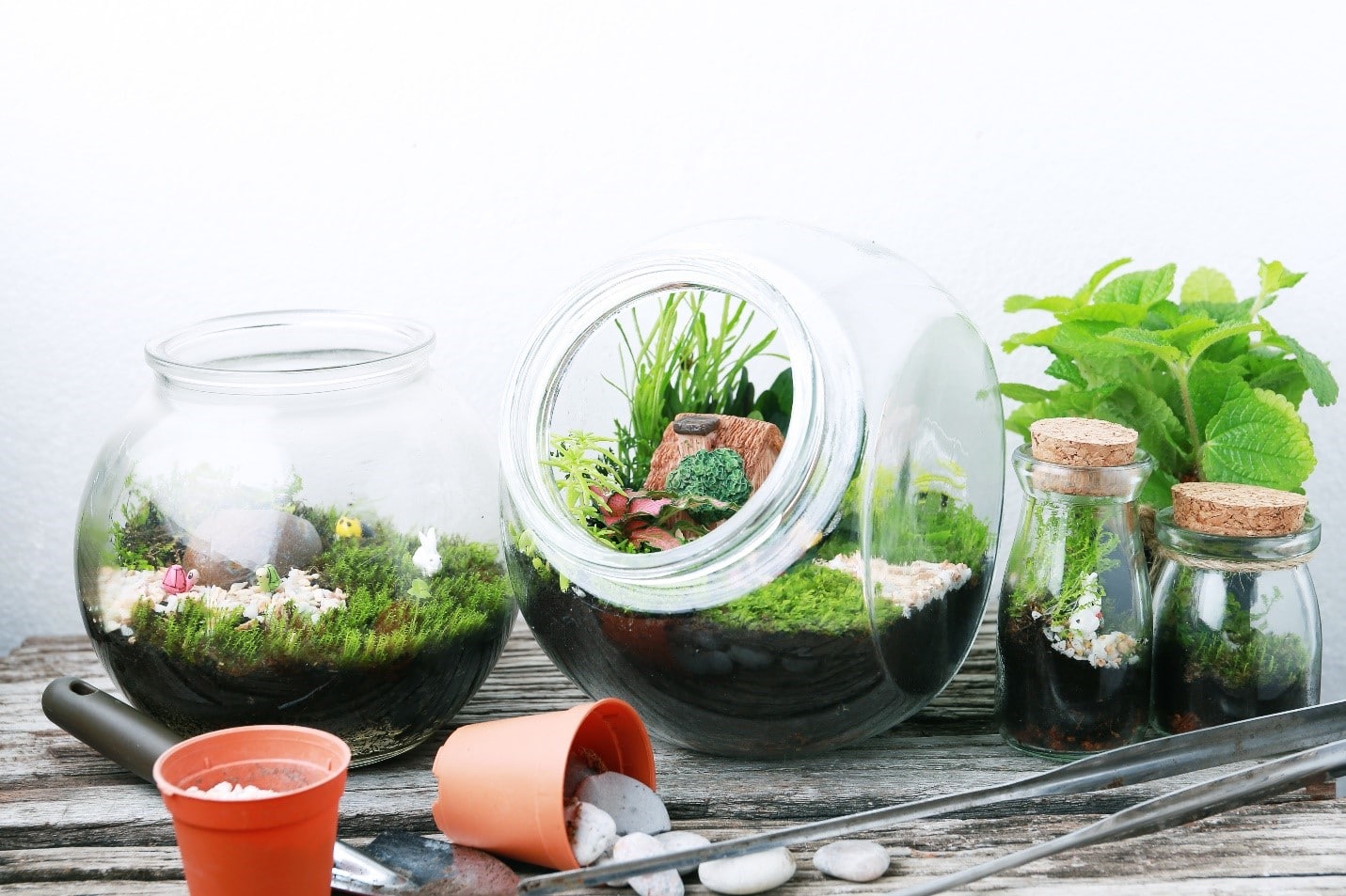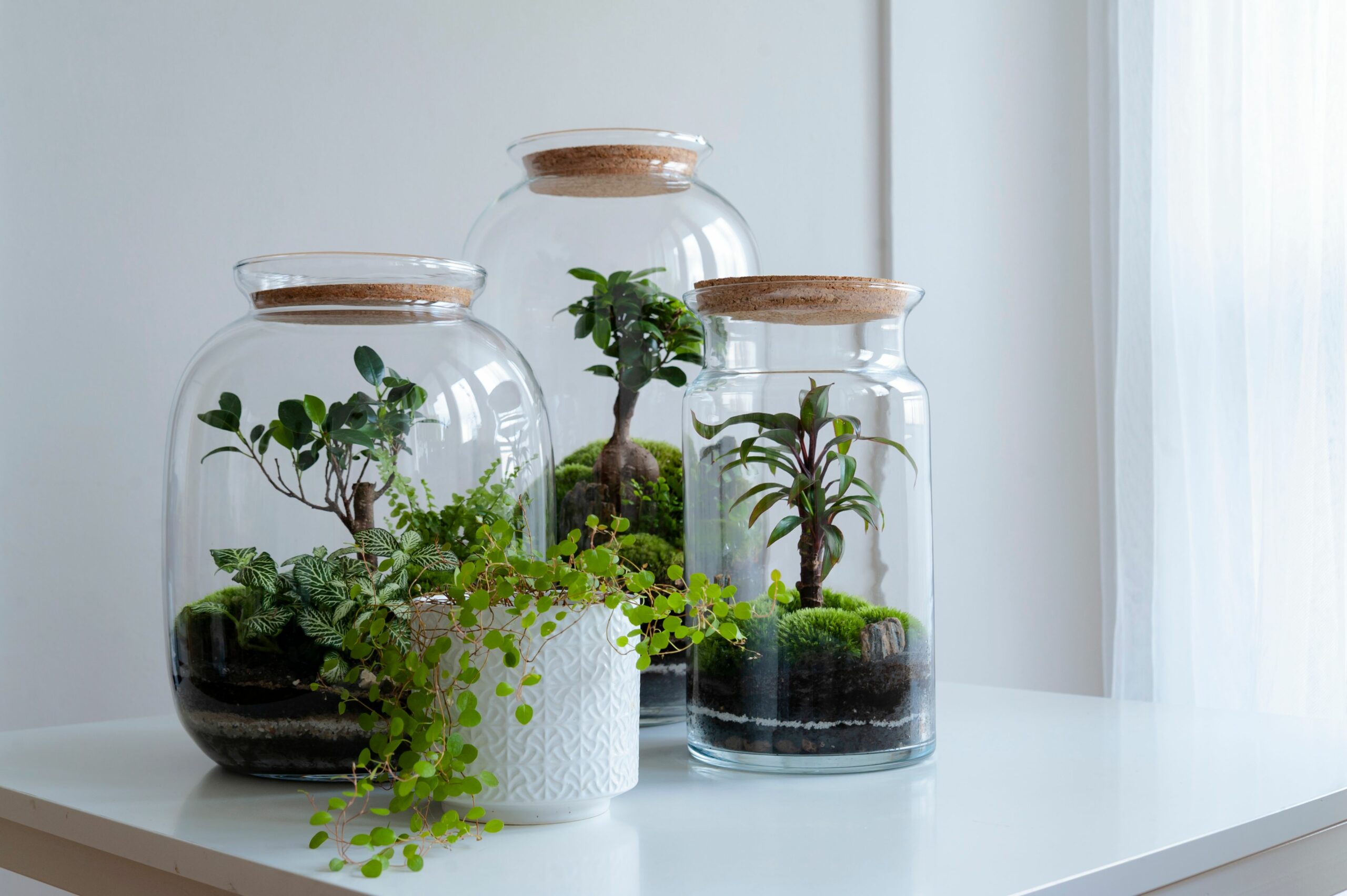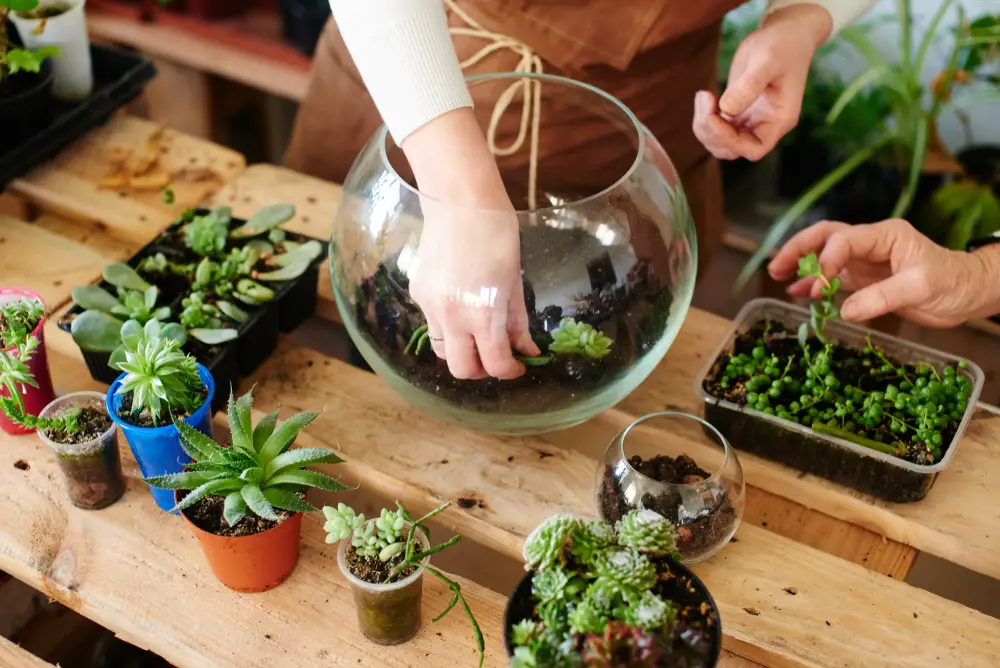If you’re looking for a new hobby, I’ve got great news for you. Home Terrarium is a great way to spend your time. There are really only 5 basic components to a Terrarium! Combine these components together, your Terrarium is pretty much good to go.
Here are the 5 Layers of a Terrarium:
- The Drainage Layer
- The Soil Layer
- Hardscape Layer
- The Plants Layer
- The Final Decorations Layer.
Now, let us get into what each of those layers is and what purpose they serve in your Terrarium.
The 5 Layers.
Here’s a great way to create a miniature garden in your room that will always brighten your mood.
We will get you covered with everything you need to know about Terrariums. From definition and inspiration to creation and care.
You’ll certainly start enjoying your miniature garden in no time at all.
Let’s make sure you have all the supplies you’ll need to get started and you’re on track to a stable and beautiful, picturesque build.
Though making a Terrarium is like building a house. It needs a solid foundation, some supporting structures, and finally a whole bunch of plants.
Now, let us get into what each of those layers is and what purpose they serve in your Terrarium.
1. Drainage Layer
The drainage layer is going to be the main structure of your Terrarium. Building a solid and strong foundation underpins the whole structure. From a simple drainage layer to a complex false bottom approach.
Much more like the one beneath our home, it must be able to resist compaction and support the layers above it. This could provide a space for excess water to drain into.
First, we should choose a container. The container is part of the main structure of your Terrarium. Most of those containers are made of either plastic or glass. The important thing that you need from your container is transparency.
The sunlight needs to be able to pass through the container so that your plants can absorb it for photosynthesis.
The plastic or glass containers will work well if they are transparent. You may also consider choosing a container for its size and shape.
Generally, it is going to be easier to work with a bigger container.
The drainage layer is a layer of rocks or pebbles that allow water to drain away from the soil. It does not substantially provide your plants with any nutrients but simply creates space for water to drain away from the substrate.
The water could freely drain into here from the substrate thus protecting your plants from soggy soil and root rot. The drainage layer will simply collect the excess water at the bottom of the container.
Materials:
- Glass or Plastic Container
- Lightweight rock, small pebbles (Spherical Shape)
- Coarse sand
The thickness of this layer is roughly one or two inches. Anything larger that could allow too much water to collect at the bottom.
However, just keep this layer relatively small so that you have more space for the other layers and for the plants in your Terrarium.
2. The Soil Layer
The soil in your Terrarium serves as the nutrient layer of the plants. The soil is where your plants will be growing their roots and getting their nutrients. However, if the soil does not have enough nutrients, to begin with, this will lead to stunted growth of your plants.
Make sure that there are no unwanted pests, chemicals, and preservatives hitching a ride in your soil.
The right potting soil mix shall be used, and it will depend on the type of plant you will be using in your Terrarium.
The right choice of plants to build, but if you go for tropical plants then good drainage, water retention, and aeration are the qualities you want to shoot for.
A potting soil mix works effectively for tropical plants as a base.
The thickness of this layer will depend on the plants you are going to put in. The Terrarium must be able to accommodate the biggest root ball and still have room for the roots to grow.
Though you can always slope the substrate to create areas for a greater and lesser depth as needed. You need a potting soil mix that has the right amount of drainage and support for your plants both nutritionally and physically.
Materials:
- Potting soil mix
- Coir (Optional)
- Sphagnum Moss (Optional)
- Aquarium soil (optional)
Coir Is an Optional Ingredient. It’s A Fibrous Material Made from Coconut Husks.
The advantages of using coir are:
1. It has a good water holding capacity, high porosity, and drainage capabilities.
2. It does not contain any pests since it is man-made coming from coconut fibers.
Sphagnum Moss is also another option like Coir. It has high water retention and is pest resistant.
Aquarium Soil is an option available for you. It is regular soil that has been baked into dry pellets. It comes from volcanic granules with a lot of minerals.
It is a great way for your plants to get their nutrients without adding organic matter to the soil. It is in the form of pellets that promote a lot of drainage in the substrate and is very helpful to prevent root rot and molds.
3. The Hardscape Layer
In building a Terrarium, Hardscape is a term for the tough, physical elements that you might add like decorative rocks, driftwood branches, crystals, and pebbles.
Hardscape could include almost any type of decorative structure in a landscape in your Terrarium. It is a critical part of landscape design.
Provide a definition of your structural design and sense of organization to the natural areas and features.
The Hardscape layer can help elevate a Terrarium in different things:
It helps build a solid base. Embedding the large objects in the substrate could be a great help to stabilize it.
It creates a sense of depth. You could physically manipulate the Terrarium landscape by your own design. Adding large objects at the front and smaller ones at the back.
3D planting opportunities. The rocks and wood branches are comfortable that a variety of plant species may grow on them. This allows for much more creative expression on how you plant your Terrariums.
Purely decorative. You create your own design in an organized manner with decorative structures.
The Hardscape elements are generally be added straight after the substrate as they are often the main features.

4. The Plants Layer
The plants are literally the life of your Terrarium. When it comes to choosing plants for your Terrarium, here are some guides for you to stick to:
- Choose plants that can tolerate high humidity.
- Choose plants that don’t grow too big.
- Choose plants that can tolerate low or indirect light.
- Choose plants that share similar living requirements with each other.
Not all plants are suitable for a environment. Ferns and moss are highly recommended by Terrarium lovers. These plants love high humidity and generally don’t grow too big within the Terrarium.
The semi-aquatic plants and miniature vines are great options for a tropical closed Terrarium thus air plants need some occasional airflow.
On the other hand, you may gather plants native to your area. Since these plants have already acclimated to your region, chances are high for them to survive in your Terrarium.
Remember to be careful not to bring in any unwanted pests. It is helpful to give the plants a little soak of some water to get rid of any pests.
Once done planting your focal pieces, then you can arrange the rest of your plants to accentuate them.
Not just the bigger plants will be harder to place when your Terrarium is full, but it is because your feature plants should take priority in the best viewing spots.
Mosses should come last because they may cover the exposed earth for a more natural look. Putting a moss is great for pulling together the final look. Some wonderful driftwoods are great additions.
5. The Final Decorations Layer
This is the final level by using decorations for the perfect finish for your Terrarium. Most of the decorations won’t influence the health of your Terrarium, but they do a great job of making your Terrarium look more interesting.
Pinterest is so helpful for a lot of cool designs people have come up with.
You may choose from all sorts of different knick-knacks, figurines, and various techniques to create the look of what you are aiming for. It is entirely up to you how you decorate your Terrarium. What do you use to do it?
However, the common ways to add decorative layers are by covering the soil with decorative stones, and seashells, and placing figurines amongst the plants.
A waterfall feature is a great option. The stones, petrified woods, pebbles, and crystals are a great idea as they would not degrade or rot away over time.
What is a Terrarium?
It’s a collection of small, decorative plants growing in an enclosed environment. Terrarium containers are typically transparent. They may provide an opening big enough to allow the gardener to access the plants inside.
One good thing – and probably the best part about a DIY Terrarium – is that you get to create something unique – a one-of-a-kind miniature garden.
What does Terrarium mean? It comes from the Latin Terra means earth + arium, a place or receptacle. Just like an aquarium, only plants, and earth instead of fish and water.
A Terrarium is perfect for people who love the natural world and live in a city with no garden and little space for plants. Otherwise, those people who like a stunning collection of exotic plants require very little maintenance.
How Does a Terrarium Work?
A Terrarium is an indoor garden in a sealed container and has a fully functioning miniaturized ecosystem. The water within the Terrarium sustains the plants by creating a miniature water cycle.
Within the process, the plants, and the soil release water vapor. The vapor is collected into the walls of the container and trickles down to the soil.
Understanding basically how it works in the water cycle and the carbon cycle.
The warmth and the humidity from the sun cause moisture to evaporate from the plants and soil. In which condenses on the cooler inside surfaces of the glass container.
Just like rainfall, the water drips/falls back down into the soil and voila! The process starts again.
The soil provides nutrients for the plants. These nutrients somehow would replenish as the plants die and decompose into the soil.
What is an Open Terrarium?
An Open Terrarium does not need to hold moisture. So primarily you would not need a lid or a water-retentive substrate. Succulent plants and cacti are plants best suited for an Open Terrarium.
However, it needs excellent drainage for optimum conditions. A drainage layer is a must for an Open Terrarium. Your substrate should have plenty of drainage elements in it as well.
It takes a different approach to water a Succulent Terrarium which is much less frequent. You would need to give it plenty of time to dry out.
Open Terrariums tend to be placed in full sun. Rather than the standard bright indirect light for tropical Terrarium which dries out much faster.
Final Thoughts on The 5 Terrarium Layers
Terrariums have been around for long years; this lush miniature garden structure is trendy now for good reason. Having the right plants and the right light, your little ecosystem can thrive for a very long time.
Bringing beauty, nature, and a sense of otherworldliness to your home, are gorgeous Terrariums with tropical shade-loving ferns and moss, together with the ever-popular desert scape of succulents.
Your Terrarium’s home starts with a plastic or glass container. It could also be an apothecary jar, a goldfish bowl, or a hurricane vase.
A reminder: It’s easier to work with a vessel with a wide mouth opening so you can fit your arm inside and manoeuvre plants. Thus, you also have more space for a larger Terrarium landscape.
The important key to building a Terrarium is to create artificial drainage with layers of material which is exclusive to the type of Terrarium you’re making. The other key is the soil you use.
Terrariums have captured our imagination at Green Garden Tribe, and we know you’ll find the above information helpful and motivational enough to get you started on your first personally conceptualized miniature ‘garden in a glass!’
We all wish you great imaginings so that you can create a beautiful jewel of a Terrarium – or make two and spread the love!
Have fun and happy gardening!
Read More:


